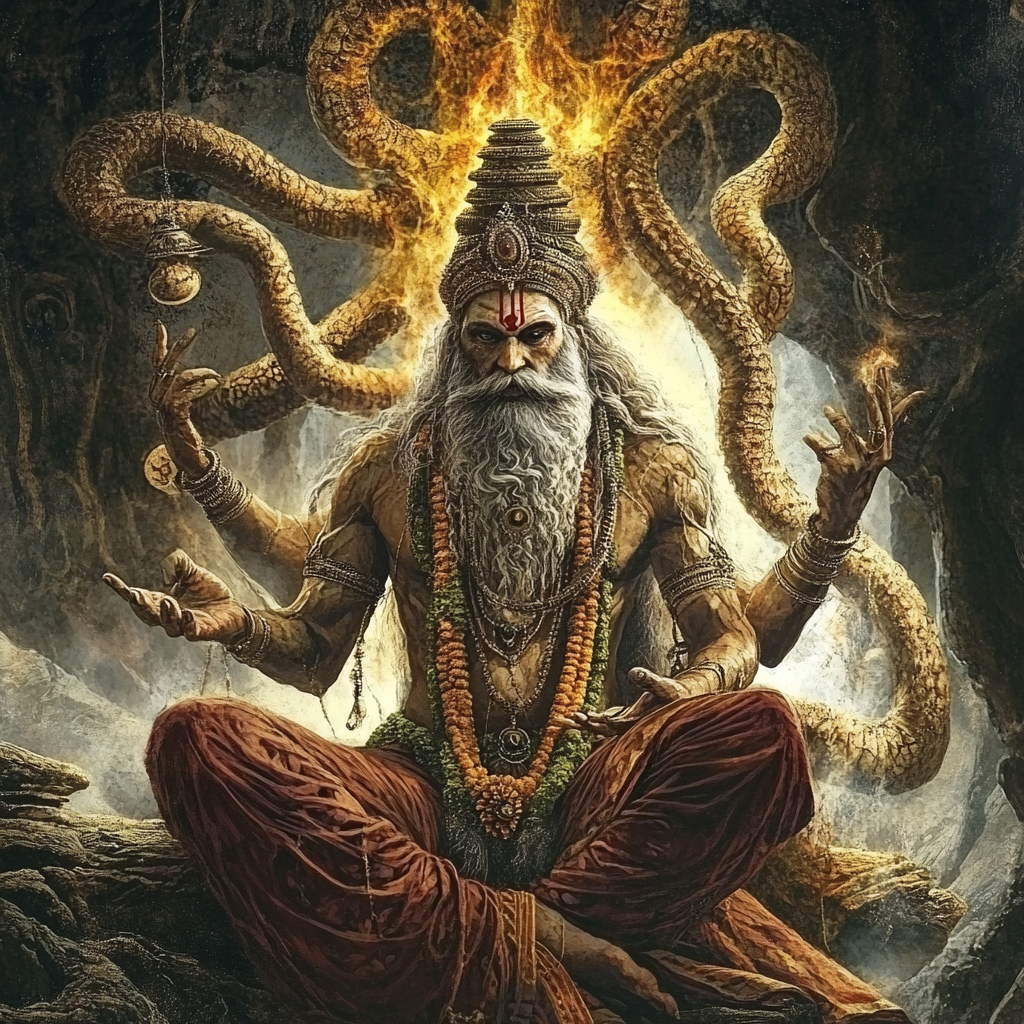To begin an inquiry into the sacred magical systems of India, we must first establish a vocabulary—a set of definitions that, while inevitably provisional, can serve as a consistent compass. In Indian contexts, definitions often flex around context and intent, and so must ours.
Scripture (Śāstra): Texts accepted as revealed (śruti) or divinely sanctioned (smṛti) by a religious community. Their purpose is soteriological: liberation (mokṣa) or divine love (prema). Vedas, Upaniṣads, Purāṇas, and certain Tantras fall under this umbrella.
Religion: A framework centered on surrender, devotion (bhakti), and ethical orientation toward transcendence. In Vaiṣṇava traditions, this entails devotion to Viṣṇu-tattva (the Supreme Reality), distinguished from demigod worship for temporal gain.
Magic: The technical application of sacred or esoteric knowledge—mantra, yantra, tantra, or ritual—to achieve specific outcomes. These outcomes may be material, psychic, or metaphysical. Magic is not anti-religious, but its orientation tends toward control rather than surrender.
The Sacred Technologies: Mantra, Yantra, Tantra, and Nāma
India's magical lexicon is highly formalized:
Mantra is not a mere word but a vibrational form of a deity. It can be used devotionally or magically, depending on intent.
Yantra is sacred geometry—the visual body of a deity or cosmic principle.
Tantra in its root sense means a loom or framework. It is that which extends or weaves together. In this context, it is a ritual manual or cosmological map designed to conjoin human and divine.
Nāma (the Divine Name) is not symbolic; it is considered identical to the deity it represents, especially in Vaiṣṇava theology.
These are not isolated categories. A mantra may encode a nāma and be inscribed in a yantra, the entire process laid out in a tantra. Thus, Indian magic is not free-form mysticism—it is a sacred science.
Magic in the Mahābhārata and Rāmāyaṇa: A Panoramic Theater of Power
Indian epics do not treat magic as superstition, but as reality. The world of the Mahābhārata and Rāmāyaṇa is populated with magical weapons (astras), curses, boons, shape-shifters, and divine illusions. Śākuni conjures dice; Indrajit vanishes mid-battle. Arjuna's astras are activated by mantra. Viṣṇu incarnates as Mohinī to deceive demons. In these texts, magic is not marginal—it is foundational.
Importantly, these stories are believed to be real by millions. This collective acceptance deeply informs both formal and folk practices. If a Rakṣasa can fly through the air by uttering the right sound, then so might a village healer repel illness through mantra.
The Veil Between Dharma and Sorcery: Why the Distinction Matters
To Western eyes, the difference between a saint performing a miracle and a sorcerer casting a spell is often lost. In Indian thought, however, the distinction lies in intent, not in method. Mantras may be used to summon blessings or to bind enemies. Fire sacrifice may purify karma or invoke wealth. What separates dharma from sorcery is not the ritual act, but the ethical and spiritual orientation of the practitioner.
This is why both gods and demons in Indian stories possess magical power. What matters is how that power is wielded.
Vaiṣṇava Theology and the Relationship Between Religion and Magic in Folk Culture
Vaiṣṇava texts such as the Bhagavad-gītā and Bhāgavata Purāṇa draw distinctions between pure devotion (bhakti) to Viṣṇu and ritual acts performed for material desires (karma-kāṇḍa). Yet even these texts acknowledge the validity of demigod worship and ritual magic as stages on the spiritual path.
Importantly, the boundaries between religion and magic in India are not always clean. The epics are accepted as histories (itihāsa), and the magical events within them are considered real by folk practitioners. This has shaped village ritual and household magic: mantras for protection, yantras for fertility, rituals to counter evil eye, and offerings to local deities are part of the continuum of spiritual life.
Rather than portraying magic as a degeneration of religion, this work acknowledges it as a legitimate, culturally embedded technology of sacred interaction. It is the mode, not the material, that defines alignment. Ultimately, Intent is the Compass. Intent directs trajectory. One may recite "Om Namo Nārāyaṇāya" with devotion, or with the aim of acquiring mystic power. The syllables remain the same; the outcome diverges.
Karma-kāṇḍa, the Vedic ritual system for material gain, is a border case. It is sanctioned, but transitional. Its purpose, ideally, is to elevate the soul toward renunciation, not bind it to rebirth. This is where magic often dwells: not outside religion, but at its threshold.
Final Framing: Religion is Relational, Magic is Transactional
In Indian tradition, the key difference is not between method, but between offering and control:
Religion is relational: it seeks surrender, grace, and unity with the divine. Its core mood is "Let Thy will be done."
Magic is transactional: it seeks efficacy, mastery, and visible result. Its core mood is "Let my will be done."
Yet even this distinction bends. Tantric initiation begins with surrender. Bhakti may result in miracles. The categories are fluid—but the axis is clear.
Indian sacred magic does not separate science from sanctity. It unites the technical with the theological. The heart of this work is to explore that fusion—not to classify one as false, but to illuminate how they function within the living cosmos of Indian spirituality.
I will make the complete text of this article (quite extensive) available to registered users.
References:
Flood, Gavin. The Tantric Body. Oxford University Press, 2006.
White, David Gordon. Sinister Yogis. University of Chicago Press, 2009.
Goldman, Robert. The Rāmāyaṇa of Vālmīki. Princeton University Press, 1984–2009.
Debroy, Bibek. The Mahabharata. Penguin India, 2010–2015.
Bryant, Edwin. Krishna: A Sourcebook. Oxford University Press, 2007.
Woodroffe, Sir John. Shakti and Shakta. Ganesh & Co., 1918.
Dimmitt, Cornelia & van Buitenen, J.A.B. Classical Hindu Mythology. Temple University Press, 1978.


Member discussion: